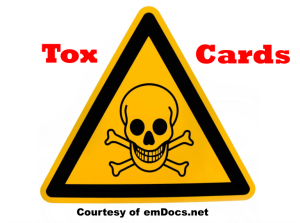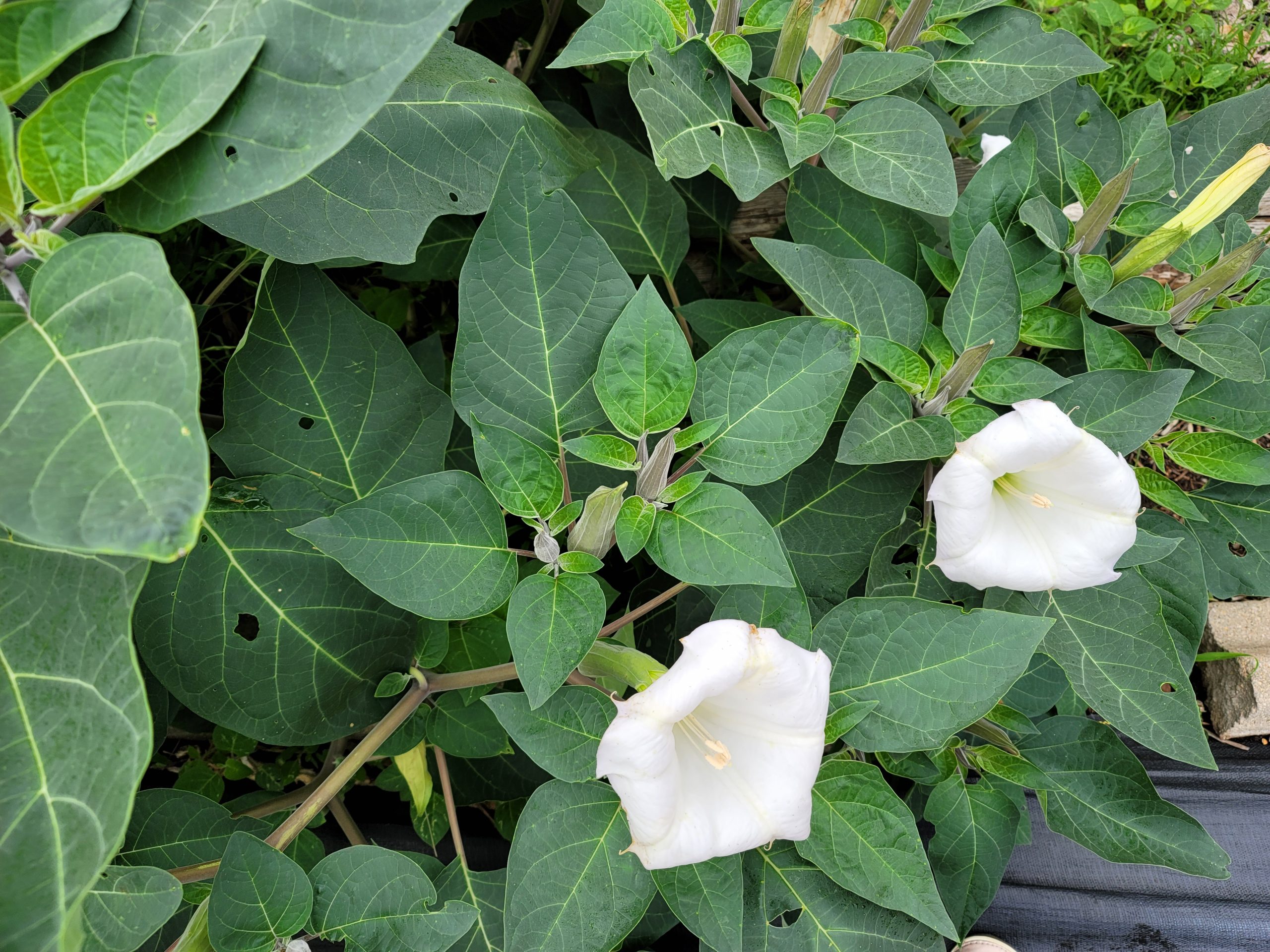Authors: Angela Pikus, MD Emergency Medicine Resident, Atrium Health’s Carolinas Medical Center); Christine Murphy, MD (Emergency Medicine Attending, Medical Toxicologist, Atrium Health’s Carolinas Medical Center) // Reviewed by: Anthony Spadaro, MD (@TSpadaro91, Medical Toxicology Fellow, Rutgers New Jersey Medical School, Newark, NJ); James Dazhe Cao, MD (@JamesCaoMD, Associate Professor of EM, Medical Toxicology, UT Southwestern Medical Center, Dallas, TX); Alex Koyfman, MD (@EMHighAK); Brit Long, MD (@long_brit)

Case:
A 17-year-old male is brought in by his mother to the ED for evaluation of changes in behavior and hallucinations. The patient’s mother states he was with friends earlier in the day and endorsed eating a plant for fun. The patient’s vital signs include heart rate 122 bpm, blood pressure 140/85 mmHg, respiratory rate 22 breaths/min, oxygen saturation 97% on room air. On physical exam, he has dry mucous membranes, dilated pupils at 5 mm bilaterally, decreased bowel sounds, flushed and warm skin, and a distended and firm lower abdomen.
Questions:
- What are the different types of anticholinergic plants?
- How does anticholinergic toxicity present clinically?
- What is the management of anticholinergic plant toxicity?
Background:
- Many of the common plant causes of anticholinergic toxicity are part of the Nightshade (Solanaceae) family.1
- These plants contain tropane alkaloids such as atropine (mixture of d-hyoscyamine and l-hyoscyamine) and scopolamine which are muscarinic receptor antagonists.1
- The tropane alkaloids are contained in the stems, leaves, and seeds of the plant in variable concentration, and ingestion can lead to toxicity characterized by anticholinergic symptoms.2
- Jimson weed (Datura stramonium, Figure 1) is one of several anticholinergic plants that if ingested can cause anticholinergic toxicity.3

Figure 1. Jimson Weed, Datura stramonium. (Photo courtesy of James Cao)
- Other examples of tropane alkaloid plants include:2
- Deadly nightshade (Atropa belladonna)
- Angel’s trumpet (Brugmansia sp., Figure 2)
- Sacred datura (Datura wrightii)
- Black henbane (Hyoscyamus niger)
- Mandrake (Mandragora officinarum)

Figure 2. Angel’s Trumpet, Brugmansia sp.(Photo courtesy of James Cao)
- Each plant is native to specific areas of the world but can be found more broadly.3-6
Clinical Presentation:
- Symptoms include altered mental status, tachycardia, hyperthermia, urinary retention, mydriasis, blurred vision, dry skin, hallucinations.1
- Duration of symptoms can last from hours to days.1
- Once the symptoms resolve, patients often have no recollection of any of the events that occurred while they were acutely intoxicated.
Diagnosis:
- Clinical exam findings, in combination with a thorough history help to make the diagnosis of anticholinergic plant poisoning.
- No specific laboratory finding confirms if a patient has ingested a plant.
- Assessing for the use of any medications or other substances that may lead to anticholinergic effects (e.g., over the counter allergy medications containing diphenhydramine, antidepressants) is vital.
- Anticholinergic toxicity has overlap with other toxicological causes of hyperthermia which are reviewed here: Hyperthermia in the Toxicological Setting.
Management:
- To prevent additional absorption, you can consider giving a dose of activated charcoal to patients presenting within 1-2 hours after ingestion of seeds or a large amount of the plant, if clinically appropriate (patient is alert, protecting their airway, and has active bowel sounds).
- An electrocardiogram should be obtained to evaluate QRS and QTc intervals, particularly if there is suspicion for co-ingestion with any drugs.
- Management of anticholinergic plant toxicity is supportive care.7
- This includes intravenous (IV) fluids for hydration, external cooling for hyperthermia and generous use of benzodiazepines to help control agitation/delirium.
- Avoid using anticholinergic medications like diphenhydramine and benztropine to control agitation.
- Delirium and agitation can worsen as patients receive IV fluids if they have urinary retention. Consider foley placement if there is evidence of urinary retention.
- Sometimes, patients will require intubation for agitation, delirium, or management of hyperthermia.
- In moderate to severe cases of anticholinergic toxicity, physostigmine may be used in the right patient scenario for diagnostic and therapeutic reasons.8 However, it is not considered first line in treatment of anticholinergic toxicity and is not available in all emergency departments.7,9
- Physostigmine inhibits cholinesterase, and thus prevents the breakdown of acetylcholine. While it acts on both central and peripheral cholinesterases, physostigmine only reverses antimuscarinic symptoms. Physostigmine does not reverse seizures or dysrhythmias.7,10
- Contraindications include asthma, chronic obstructive pulmonary disease (COPD), genitourinary or gastrointestinal obstruction, or if there is suspected or confirmed tricyclic antidepressant (TCA) overdose.9
- Physostigmine dosing: 0.5-2 mg increments IV in adults every 5-15 minutes up to a maximum of 2.0 mg; for children, can use 0.02 mg/kg IV, up to a max of 0.5 mg.7,9,10
- As physostigmine is a cholinergic agent and can cause bradycardia, patients should always be on a cardiac monitor, with close physician supervision, and with atropine and benzodiazepines readily available in case the patient develops significant cholinergic toxicity.7
- Administer this antidote slowly via intravenous route over several minutes (5-10 minutes), as rapid administration is associated with seizures and bradycardia.7,10
- Physostigmine has a short half-life and rapid elimination, so repeat doses are often necessary. Physostigmine can be rebolused every 20-90 mins. Occasionally, physostigmine infusions have been used.9,10
- A more detailed discussion on the use of physostigmine in anticholinergic toxicity is discussed here: Physostigmine for Management of Anticholinergic Toxidrome.
- Recent drug shortages have affected the ability to routinely stock physostigmine in the US. Rivastigmine, also a cholinesterase inhibitor, is currently being investigated for its utility as an adjunct or alternative to physostigmine in the setting of anticholinergic toxicity.11
- Consider consulting a toxicologist or regional poison control center (1-800-222-1222 in the United States) if there diagnostic or management uncertainty.
Case Follow-up:
The patient administered two doses of midazolam for intermittent agitation. His agitation improves, he has resolution of his hallucinations, and he returns to his baseline mental status. His vitals also improve, and he is subsequently discharged from the ED.
Clinical Pearls:
- Anticholinergic plants such as jimson weed, angel’s trumpet, deadly nightshade, sacred datura, black henbane, and mandrake have anticholinergic properties due to their tropane alkaloids.
- Ingestion of these plants can lead to anticholinergic symptoms.
- Clinical presentation includes tachycardia, altered mental status, mydriasis, urinary retention, agitation, and delirium.
- Treatment includes supportive care such as IV fluids, benzodiazepines for agitation and delirium, and in some cases physostigmine.
References:
- Nelson LS, Goldfrank LR. In: Nelson LS, Howland M, Lewin NA, Smith SW, Goldfrank LR, Hoffman RS. eds. Goldfrank’s Toxicologic Emergencies, 11e. McGraw Hill; 2019. Accessed April 15, 2023. https://accessemergencymedicine-mhmedical-com.libproxy.lib.unc.edu/content.aspx?bookid=2569§ionid=210276997
- Soulaidopoulos S, Sinakos E, Dimopoulou D, Vettas C, Cholongitas E, Garyfallos A. Anticholinergic syndrome induced by toxic plants. World J Emerg Med. 2017;8(4):297-301.
- Chan, K. Jimson weed poisoning – a case report. The Permanente Journal. 2002; 6(4):28-30.
- NC State Extension. Atropa Belladona. Accessed April 15, 2023. https://plants.ces.ncsu.edu/plants/atropa-bella-donna/
- Lee MR. Solanaceae IV: Atropa belladonna, Deadly Nightshade. J R Coll Physicians Edinb. 2007;37:77-84.
- Kim Y, Kim J, Kim O, Kim W. Intoxication by angel’s trumpet: case report and literature review. BMC Research Notes. 2014;7:1-3.
- Dawson A, Buckley N, Pharmacological management of anticholinergic delirium – theory, evidence and Practice.British Journal of Clinical Pharmacology. 2015;81(3):516-524.
- Wang GS, Baker K, Ng P, Janis GC, Leonard J, Mistry RD, Heard K. A randomized trial comparing physostigmine vs lorazepam for treatment of antimuscarinic (anticholinergic) toxidrome. Clin Toxicol (Phila). 2021 Aug;59(8):698-704. doi: 10.1080/15563650.2020.1854281. Epub 2020 Dec 9.
- Phillips M, Acquisto N, Gorodetsky R, Wiegand T. Use of a physostigmine continuous infusion for the treatment of severe and recurrent antimuscarinic toxicity in a mixed drug overdose. Journal of Medical Toxicology. 2014;10(2):205-209.
- Howland M. Physostigmine Salicylate. In: Nelson LS, Howland M, Lewin NA, Smith SW, Goldfrank LR, Hoffman RS. Goldfrank’s Toxicologic Emergencies, 11e. McGraw-Hill Education; 2019. Accessed January 22, 2024. https://accessemergencymedicine-mhmedical-com.libproxy.lib.unc.edu/content.aspx?bookid=2569§ionid=210262404
- Greene, Spencer C. Rivastigmine Use in the Treatment of Antimuscarinic Delirium. Journal of Medical Toxicology. 2023;19(3):284-287.








